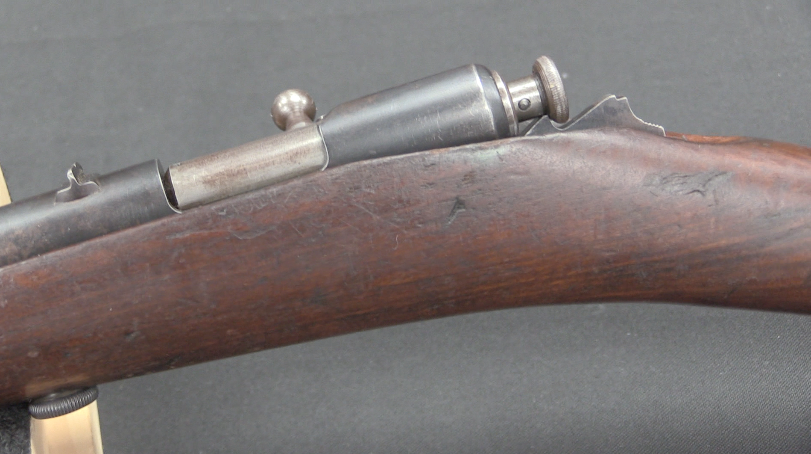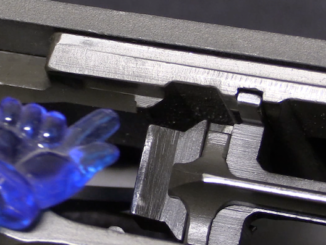Patented in 1879 by Reuben Chaffee and General James Reece, the Chaffee-Reece rifle is an excellent example of how an idea that seems good on paper can easily become untenable in a fielded rifle. The main design premise of the rifle was to have a tubular magazine in the buttstock which held the cartridge out of contact with other, as opposed to being pressed together by a magazine spring as in a conventional design. This would notionally prevent any possibility of recoil or other forces causing the bullet of our round to impact the primer of another and cause a detonation in the magazine.
In initial testing by the Army in 1882, the prototypes were appealing, and a field trial of 750 rifles was requested. Chaffee and Reece were unable to find a commercial manufacturer willing to take on the production (except Colt, which offered to make just 200, and at the cost of $150 etc), and they ultimately turned to the government-operate dSpringfield Arsenal to built the guns. A total of 753 rifles were made by Springfield in 1883 and 1884 (interestingly, not serial numbered) and delivered for testing.
That testing went quite badly. The magazine was a very complex system, using two sets of basically reciprocating racks to shuttle cartridges up the magazine as the bolt was cycled, without allowing them to contact each other. It proved very prone to jamming and breakage, and was both extremely difficult to keep clean and very susceptible to, as they would have called it at the time, “derangement”. It was handily beaten by the Winchester Hotchkiss 1885 pattern rifles (among others) in field trials, and that was the end of its potential for adoption. The rifles were eventually sold as surplus, and bought by the Bannerman company, where they remained in stock and available for purchase until at least 1907.




Oh dear, it seems that another overly complex design has gone wrong. Well what did you expect? A flat nose round could deal with not impacting primers under spring pressure when inside a tube… did I mess up?
Complicated does not mean unreliable. Main problem is that, if you have many moving parts, is to guarantee that all elements position and rotations are properly synchronized – as all parts with usage worn down, you must also consider “non-ideal” parts. Especially problematic might be “stacked” dependencies, say part A will be positioned properly, if part B will be positioned properly, but part B requires parts C and D to be positioned properly e.t.c.
But that might be done, now more importantly: it will be disassembled and assembled, to avoid mishap best solution: it only fits right way.
–
For example of successful tube magazine for cartridges with Spitzer bullets, see Remington Model 14 or Remington Model 141 (I don’t found any evidence of negative user experience with its magazine, so I assume it is reliable enough, can anybody prove or deny it?)
Lebel also had tube magazine with pointed bullets.
They got around the primer problem by making the cartridge case head with an annular depression to “catch” the point of a bullet before it could contact the primer;
http://www.warrelics.eu/forum/attachments/ordnance-ammo/58306d1255813227-wwi-live-french-lebel-bullet-l-1.jpg
I’ve always been surprised that American makers of ammunition for tubular-magazine rifles didn’t pick up on this idea. While it theoretically weakens the case head, in reality it doesn’t matter much with sensible pressure levels.
Such cartridges as the .30-30 WCF, .32 Win. Special, and etc. could all benefit from spitzer-type bullets rather than their usual semi flat-nosed types. Especially at ranges over 200 yards.
cheers
eon
I am not sure if that idea would work very well with cartridges that have less taper than 8×50mmR Lebel.
“Such cartridges as the .30-30 WCF, .32 Win. Special, and etc. could all benefit from spitzer-type bullets rather than their usual semi flat-nosed types. Especially at ranges over 200 yards.”
Possible solution might be cases with elongated neck, and bullet seated so deep so it would be totally hidden (like in 7,62x38R Nagant).
However this would need alerting chamber, for accepting such cartridges.
is: “(…)alerting(…)”
should be: “(…)altering(…)”
From what I understand, loading the weapon was slow, as the action had to be cycled for each round loaded. Load one round, cycle the action to move the round forward and make room for the next round to load. I imagine this would add to the wear and tear a bit. I wonder if Ian could confirm.
Also, someone explained to me a long time ago, that one ratchet rail moved up and down only to secure the cartridges in position, moving down so that the other rail (which moved laterally and up and down) could move the cartridges forward. I don’t recall which (left or right) was which.